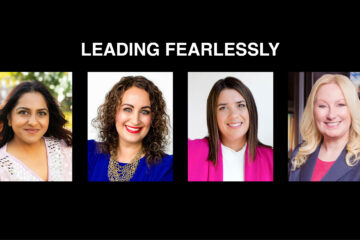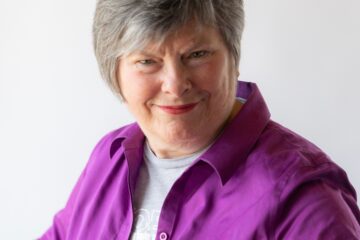By Emily Kestel, Fearless editor
The theme of this year’s Women Lead Change Central Iowa Conference was “Joining Voices: Leaders for Equity.”
One way I like to practice equity is by sharing knowledge. In this case, sharing knowledge looks like sharing the highlights of my nine pages of notes.
Before you assume that because the conference has the word “women” in it that’s only meant for women, think again. The following takeaways can be of use to anyone.
Adults don’t laugh nearly enough, and fear is a big reason why.
The average toddler laughs 300 times a day. By the time you reach 40, that number drops to an average of four times a day.
Fear has a big role in our lack of joy, author Judi Holler said in the opening keynote address. That manifests itself through comparison, doubting ourselves, staying in our comfort zones and caring what other people think.
A lot of this comes from always being on our devices.
One survey found that 81% of employees check their work email on weekends and 59% stay on top of their emails while on vacation. Another survey showed that the average U.S. worker spends 6.3 hours a day checking email. Additionally, Americans spend more than two hours a day on social media.
“We’re not unplugging,” Holler said. That leaves less time to do things that make you feel alive.
“Being brave requires stamina, focus and being awake,” she said. “You cannot be exhausted, crazy busy, overwhelmed, sick AND be brave.”
Holler recommends people conduct “small fear experiments” every day. This could be walking up to someone and introducing yourself, sitting in the front row of a meeting, speaking up first on a conference call or wearing a new color or pattern.
Men are the missing ingredient to getting to gender equity.
Until men step off the sidelines and call out bias and mistreatment of women, contribute their fair share of work at home, and educate themselves about women’s experiences, gender equity will not be a reality.
The authors of “Good Guys: How Men Can Be Better Allies for Women in the Workplace,” Brad Johnson and David Smith, spoke at length about the importance of being a good ally at work and at home.
“Gender allyship skills are gateway skills,” they said. Once you nail down the best practices of being a good ally to women, it’s easy to become an ally for other underrepresented or marginalized identities.
Johnson and Smith recommended that men abide by the 36-minute campaign, first implemented by JP Morgan Chase.
For 30 minutes a week, get coffee or lunch with a talented or up-and-coming woman. Spend five minutes a week congratulating female colleagues on a job well done or a personal success. Lastly, take just one minute a week talking up a woman to other colleagues.
Doing this drastically improves women’s professional development and growth.
Yes, you do have time to do what you want.
News flash: Everyone has the same amount of time as everyone else.
If it feels like you don’t have time to do what you need or want, perhaps you should track your time for a week to see where it’s going, author Laura Vanderkam said.
“We’re resistant to do this because we don’t want to know how much time we’re wasting,” she said.
Vanderkam suggests creating categories for every type of task you do – whether it’s eating, working, sleeping, driving, running errands, watching TV or cooking – and then jotting down how much time is spent doing each.
Then ask yourself: What do I like the most? What do I want to do more of? What do I want to get off my plate?
Use that as a guiding point for planning out your weekly schedules. Do you enjoy cooking but hate going grocery shopping? Consider getting your groceries delivered and then use that time saved to cook a meal you wouldn’t have been able to otherwise.
“When you say, ‘I don’t have time,’ what you really mean is ‘It’s not a priority,’” Vanderkam said.
Your gender plays a role in your finances.
In early 2020 – before the pandemic – Merrill Lynch and Bank of America conducted a study about the role that gender plays in wealth management.
The study found that 8% of women have had a negative experience with a financial adviser based on their gender. That might not sound like a lot, but it’s more than double that of men.
Advisers also demonstrated an average of 10 miscues in 30 minutes, some of the most frequent being: assuming a man is the decision maker, assuming that women are less knowledgeable than men about investing and assuming that women are more risk-averse.
In her presentation at a breakout session, Merrill senior financial adviser Aleeza Singh walked through the study, summing it up by saying that there is a lot of work to be done, but there is a lot to celebrate, too.
Twenty-seven percent of women under 55 are very knowledgeable about financial products and services, compared with 6% of women over 55. Furthermore, 28% of women under 55 are very comfortable making financial decisions on their own, compared with just 9% of women over 55.
“Young women are taking [their finances] very seriously,” Singh said.
Develop a habit of checking in with yourself and how you’re feeling.
The latest Household Pulse Survey shows that 35% of women have reported feeling anxious or depressed. Furthermore, 57% of American and Canadian workers reported feeling stressed on a daily basis, according to a Gallup report.
In her breakout session, therapist Julie Larson offered several strategies to help manage stress in the workplace.
First things first: You need to develop a habit of checking in with yourself. Try to name what you’re feeling, where you’re feeling it and what you’re doing that’s helping or not helping it. Taking a brief walk or organizing your desk can help de-escalate feelings of being overwhelmed or stressed.
Using the 5-4-3-2-1 method can also help connect you with the present and reduce anxiety. Take a moment to identify 5 things you see, 4 things you can touch, 3 things you can hear, 2 things you can smell and one thing you can taste.
Larson also recommends sorting your thoughts into the past, present and future and focusing on what you can control at that moment.
Be smart about how you build your schedule.
We’ve all been there – our calendar is filled with back-to-back meetings. One runs over, which makes you late for the next one, triggering a domino effect.
To fix this, Vanderkam encourages people to schedule deliberate open space in their schedules.
“Everything takes longer than you think it will,” she said. “Open space invites opportunity.”
If you happen to have an extra five or 10 minutes between meetings or tasks, Vanderkam says to use that time for “bits of joy” like reading, stretching, praying, writing a note to a family member or enjoying your surroundings.
“Your brain needs a break,” she said.


